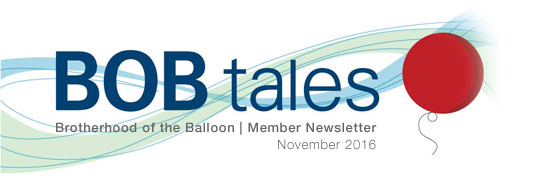
.jpg)
Dear Members:
Everybody remembers the dates of major milestones in their lives—birthdays, graduations, anniversaries, etc. August 10, 2000 was the date I received word of my prostate cancer diagnosis. That’s one day I will never forget. As I wrote in my book, I was scared to death, particularly after reflecting on the vivid memories I had of my older brother's experience with surgery.
My daughter, Deb, was engaged to be married to a wonderful man, Mark Hickey, in two months. Because of this, I thought of keeping my diagnosis quiet. I didn’t want to throw a damper on a day that was supposed to be filled with joy. I knew so little about the disease that I didn’t know if I would be able to walk Deb down the aisle.
Fast forward 16 years. On December 22, 2016, I will celebrate the 16th anniversary of completing my proton treatment at Loma Linda University Cancer Center, another date I will always remember. December 2000 also marks the birth of our organization, the Brotherhood of the Balloon, with its mission to keep our members connected, promote proton therapy, and give something back. A lot has happened during the past 16 years.
We have grown to almost 9,000 members in 50 states and 39 countries. By sharing our stories and promoting the treatment we received, we have influenced many to choose proton therapy. We have published 190 newsletters, which are now distributed to about 10,000 people around the world—promoting healthy living; providing updates on proton therapy technology and prostate cancer prevention, detection and treatment; and, telling the world about the best treatment for localized prostate cancer.
We have also given back. Our group is responsible for having contributed almost $12 million for proton therapy research and for Vision 2020 at Loma Linda University Health. I am deeply honored to have an endowed chair in my name at LLUCC, dedicated to supporting proton therapy research. This chair has more than $3 million—thanks to your contributions. The earnings from investing the principle are now being used to advance both basic and clinical proton therapy research. So, our group is making a difference in the world.
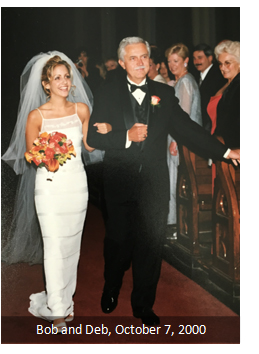 And, yes, I did walk Deb down the aisle on her wedding day. She and Mark just celebrated their 16th wedding anniversary with their beautiful daughter, Gemma, who will be six in a few months. Mark, as most of you know, had a very serious cancer diagnosis almost three years ago, and through thousands of prayers—and a miracle, in my opinion—he is cancer free today.
And, yes, I did walk Deb down the aisle on her wedding day. She and Mark just celebrated their 16th wedding anniversary with their beautiful daughter, Gemma, who will be six in a few months. Mark, as most of you know, had a very serious cancer diagnosis almost three years ago, and through thousands of prayers—and a miracle, in my opinion—he is cancer free today.
As I write these words, Pauline and I are just a few days away from flying to Venice, Italy to begin a Mediterranean cruise in celebration of our 50th wedding anniversary.
It’s Thanksgiving season, and, as you can see, my family and I have much to be thankful for, including, and maybe especially, the proton therapy I received at LLUCC that saved my life and preserved the quality of my life.
We members of the BOB are the lucky ones. Most of us had our cancers diagnosed early and most have had a successful outcome from our proton therapy. Sadly, even with all the new developments in cancer imaging and detection, there are still many who don’t have the same story to tell as you will see in this month’s BOB Tales.
We have another terrific newsletter this month covering a broad range of subjects. Our series on the important book, Anticancer: A New Way of Life, continues with part II in this issue. Few articles or series have generated as much interest and feedback as this one. We have heard from hundreds of our members informing us of the value they are receiving from this important series. Many of our members routinely forward our newsletter to friends and family. One member sent us a copy of the note he sent to his distribution list:
Folks: This issue reports on diet and other factors aimed at maintaining a healthy immune system. I’ve purchased the book, “Anticancer,” read most of it, and forwarded copies to friends who might find it useful. Have a look and decide for yourselves. As for me, I need to double down on my sugar intake goal.
In the Anticancer series, a considerable amount of attention is being given to the impact of diet on cancers and other diseases that shorten our lives. Coincidentally, it was just reported in Parade Magazine that on average, Americans eat three cheeseburgers a week. And last year, Americans consumed 50 billion cheeseburgers (yes, that’s billion with a “B”). This was announced on September 18, which is “National Cheeseburger Day.” We don’t make this stuff up, folks.
Please pay attention to our Anticancer series. This information could save your life.
As always, we welcome and encourage your feedback and suggestions to continuously improve the BOB Tales. Just send an email to Deb Hickey.
Bob Marckini
To print the BOB Tales newsletter or view the newsletter with a larger font size, click here for the PDF file.
In This Issue:
- Anticancer—And the Anticancer Lifestyle (Part II)
- Reduce Inflammation to Help Prevent Cancer
- The Importance of Keeping Up with New Technologies
- In Memoriam: Charlie Einsiedler
- Selling a Used Car and Erectile Dysfunction ...?
.jpg)
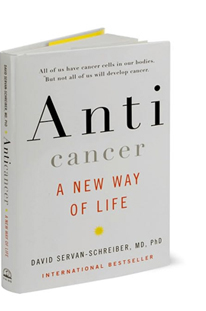 Anticancer—and the Anticancer Lifestyle (Part II)
Anticancer—and the Anticancer Lifestyle (Part II)
Last month we began a series of articles on the book, Anticancer: A New Way of Life by David Servan-Schreiber, MD, PhD. This series is being authored by BOB member, Pat Greany, PhD, retired USDA research entomologist and courtesy professor at the University of Florida.
The book’s author, Dr. Servan-Schreiber (Dr. S-S) was a 31-year-old neuro-psychiatrist and scientist/researcher who accidentally discovered he had a deadly brain tumor. In his journey to stay alive, Dr. S-S set out to learn everything he could about the causes of cancer and how to combat cancer through diet and lifestyle changes. His findings are nothing less than shocking, and Anticancer has become the best-selling book about cancer in the world. Here is the second article in our series on this important book.
Do you know there’s an epidemic of cancer occurring?
Most of the readers of this newsletter were born after 1940, which coincidentally is the year that Dr. S-S identifies as the beginning of a major increase in the incidence of cancer in the U.S. and throughout the West, and coincides with the beginning of World War II. According to Dr. S-S in Anticancer and references therein, the incidence of breast cancer has risen dramatically, from about 55 cases per 100,000 to about 140 cases per 100,000 in 2000 in the US. Prostate cancer rates have risen even faster, predominantly in the West. The PCa rate in the US grew by 258 percent between 1978 and 2000! Asians in Asia traditionally have much lower rates of these diseases, but when Asians adopt our habits, they experience a similar cancer rate, so they are not protected by genetic differences. Dr. S-S states “Cancer is a disease of the Western lifestyle.” Conversely, gastric cancers have dropped significantly since 1940, due to use of refrigeration of food rather than reliance on nitrates and salt for preservation, emphasizing the importance of environmental factors in carcinogenesis.
Principal Correlates of Increased Incidence
1. Diet, and the diet of the animals we eat:
- Sugar
- Fats, especially omega-6 fatty acids and trans-fats derived from them
2. Environmental factors:
- Pesticides (insecticides & herbicides)
- Household products (e.g. phthalates in plastics)
Genetics, Epigenetics, and the Influence of Environment Factors
Dr. S-S indicates “…cancer genes may not be so harmful if not triggered by our unhealthy lifestyle.” And, “Perhaps these much-feared genes are not ‘cancer genes’ at all, but rather ‘fast-food intolerant genes.’ There’s a new term in the field of molecular biology: ‘epigenetics,’ which refers to the study of changes in organisms caused by modification of gene expression rather than alteration of the genetic code itself. Epigenetics has transformed the way we think about genomes. It’s increasingly clear that our health is being affected by the influence of food and adverse environmental factors on gene expression, sometimes resulting in cancer, along with heart disease, diabetes, and other problems.
Dietary Influences
Two food groups stand out as being major contributors to the epidemic.
- Sugar and other high-glycemic index commodities such as bleached flour are now recognized to be major contributors to the increased incidence of cancer, along with cardiovascular disease and diabetes. This point is also well-known to practitioners of the popular Wheat Belly Diet. Dr. S-S illustrates the incredible increase in sugar consumption since the Paleolithic, when humans ate only about 4 pounds of sugar (mainly honey) per year, then about 11 pounds per year in 1830, rising to an amazing 150 pounds per year per person in 2000! Dr. S-S states, “There is good reason to believe that the sugar boom contributes to the cancer epidemic, as it is linked to an explosion of insulin and IGF (insulin-like growth factor) in our bodies.” “… a joint American-Canadian study… has shown that in a group of women under 50, those with the highest level of IGF were seven times more likely to develop breast cancer than those with the lowest. Another team … demonstrated the same phenomenon for prostate cancer: In their group of men, the risk was as much as nine times greater for those with the highest levels of IGF.”
- Omega-6 fatty acids, and especially trans-fats, are implicated as being pro-inflammatory and harmful, especially when the ratio of omega-6 to omega-3 fatty acids is out of balance. Omega-3 fatty acids, especially as found in fish, are beneficial and necessary. The widespread use of corn, soybean, palm and canola oils, rich in omega-6 FAs, to produce trans fats to make them solid at room temperature and less likely to become rancid makes them even more inflammatory than omega-6s in their natural state. Trans fats did not exist in our food before World War II. Studies in Europe confirmed that the risk of breast cancer almost doubles in women who have high levels of trans fats in their blood. Sidenote: There is a controversy regarding the use of flaxseed oil as a source of omega-3s. At the least, there is slow conversion from alpha linolenic acid to the omega-3s we need (EPA & DHA). Because corn and soybeans are primary sources for the feed for chickens, beef, and pork, these animals accumulate omega-6s rather than omega-3s from more natural food sources, adding to the problem. A great documentary called King Corn describes the tremendous increase in production and use of corn for animal feed, high fructose corn syrup, ethanol production, and a myriad of other purposes, all of which are subsidized by government programs.
Dr. S-S states (p. 78), “We finally have an explanation for the simultaneous epidemics of cancer and obesity. Changes in our diets over the last half century point to the culprit: a dietary imbalance in the ratio of essential fatty acids leading to the incredible overconsumption of omega 6s, together with the rise in insulin levels due to the higher and higher glycemic index of the modern Western diet. These imbalances are precisely the factors associated with certain cancers, or their dissemination as metastases…”
Adverse Environmental Agents
Many pesticides and herbicides have been identified as being obvious sources of environmental harm, leading to the creation of the Environmental Protection Agency in 1970. Now, many have been implicated as probable carcinogens as well, as discussed by Dr. S-S. A comprehensive review of this topic was published in 2013 and summarized in an article by Dr. Brian Lawenda, an Integrative Oncologist.
Dr. S.-S. discusses the carcinogenic potential of many pesticides and synthetic industrial chemicals, the use of which has spiked since 1940. He also identifies household products as being of concern, such as phthalates and bisphenol A, used in plastics, and he also points out the potential for interactions between different substances—the “cocktail effect.” And of course, he also speaks about the hazards associated with cigarette smoke (not only a cause of lung cancer but also a major cause of bladder cancer).
So, what are we to do? Integrative oncology to the rescue!
The famous architect and change-maker Buckminster Fuller once said, “You never change things by fighting the existing reality. To change something, build a new model that makes the existing model obsolete.” It is obvious that we need to make some changes in our lifestyle and not rely upon Big Pharma to rescue us, at great cost to society, after we’ve been diagnosed.
Dr. S-S summarizes to-do and not-to-do actions to take in Tables 5-7 of Anticancer. In our next installment, we’ll discuss some of the generally recognized anticancer foods and supplements that can be a big help in our daily lives. We’ll also discuss the increasingly obvious role of inflammation in disease, including prostate cancer, and agents plus foods that can help reduce inflammation.
Reduce Inflammation to Help Prevent Cancer
A presentation at Experimental Biology 2016 showed that some dietary habits are associated with increased risk for breast and prostate cancer Of 3,184 adults followed for more than 20 years, 565 were diagnosed with cancer. Researchers found those who drank sugary drinks had three times as much prostate cancer as those who consumed less. Foods that cause high rises in blood sugar were associated with increased prostate cancer risk. Men who ate processed foods four or more times a week had double the risk for prostate cancer. Women who ate vegetables, fruits, whole grains, and legumes were 67 percent less likely to develop breast cancer, compared with women who chose refined carbohydrates.
Another study of men with prostate cancer revealed that eating meat increased the risk of death from prostate cancer, while eating polyunsaturated fats in vegetables reduced the risk.
Other studies have shown that some lifestyle and dietary factors (see list on the following page) significantly increase the risk for cancers of the stomach, colon, biliary tract, pancreas, lung, breast, prostate, and endometrium.
Lifestyle Factors Associated with Increased Risk for Cancer
- Smoking
- Alcohol
- Chronic inflammation
- Obesity
- Lack of exercise
- Various infections
- Certain hormones
- Immunosuppression
- Cumulative lifetime exposure to radiation
- Cumulative lifetime exposure to various carcinogens
Dietary Factors Associated with Increased Risk for Cancer
- Sugar-added foods
- Sugary drinks
- Red meat and processed meats
- Fried foods and grilled or charred foods
- Lack of plants: fruits, vegetables, beans, whole grains and other seeds
- Eating refined grains instead of whole grains
How Inflammation May Cause Cancer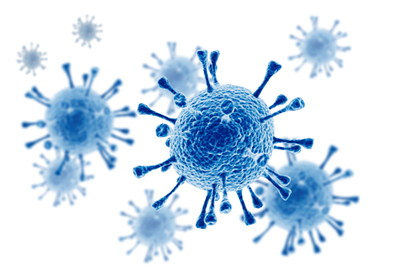
When bacteria and other microbes get into your body, your immune system produces cells and proteins that attack and kill the invading germs. As soon as the germs are gone, your immune system is supposed to slow down and stop the attack. Inflammation means that your immune system stays active and starts to attack and damage your own cells and the DNA genetic material inside them.
Normal cells undergo “apoptosis” which means that they live only a certain number of days and then die. However, if your immune system damages your DNA, the cells may not die. These cells often turn into cancer.
Causes of Inflammation
High Blood Sugar: When blood sugar levels are too high, sugar sticks to the outer membranes of the cells in your body and damages them to turn on your immune system.
Obesity: Fat cells produce the same cells and chemicals that turn on your immune system. Obesity causes high blood sugar levels; blood sugar levels rise with increases in body weight, BMI, and waist circumference.
Foods We Eat: These foods may trigger inflammation in the body:
- Sugar: Processed sugars trigger the release of inflammatory messengers called cytokines.
- Saturated Fats: Foods like pizza and cheese trigger adipose (fat tissue) inflammation.
- Trans Fats: Foods like cookies, doughnuts, fast foods, processed snack foods, etc. trigger systemic inflammation.
- Omega 6 Fatty Acids: Excess consumption of oils (corn, safflower, soy, vegetable etc.), mayonnaise, and many salad dressings can trigger the body to produce pro-inflammatory chemicals.
- Refined Carbohydrates: Processed carbohydrates may be the main driver of escalating rates of obesity and other chronic conditions.
- MSG: This chemical can trigger two important pathways of chronic inflammation, and affect liver health.
- Gluten and Casein: These common allergens, found in dairy and wheat, may also promote inflammation.
Importance of Keeping Up with New Technologies
A newly diagnosed gentleman wrote us last month:
Over a period of four years with my PSA increasing gradually from 5 to 14 and four “blind biopsies” (two at 12 samples and two at 24) failed to find any cancer, I was labeled an “anomaly” by my doctor. When my PSA jumped from 14 to 18 (in six months), my urologist ordered an MRI and then an MRI-guided biopsy. It revealed two cancerous areas that apparently were hard to find with a “blind biopsy” due to their location. I was graded a Gleason 3 + 4 = 7.
Old Technology
The message above is a good example of some doctors still using 30-year-old technology to diagnose prostate cancer. Thirty years ago doctors started taking random biopsy samples of the prostate to determine if a patient with rising PSA had prostate cancer. The biopsy needle is typically guided by ultrasound. And while ultrasound does a reasonably good job identifying the overall shape and volume of the prostate, it is not a good tool for finding small cancerous lesions within the prostate. So, this particular procedure is referred to as a “blind” biopsy, meaning the 12 or so samples the urologist takes are somewhat random. And since the samples taken add up to less than one percent of the prostate volume, the patient doesn’t know for sure what the results mean. If the biopsy shows no cancer, it’s still possible there is cancer present, but the random sampling of the prostate didn’t find it.
New Technologies
New technologies are available that can give doctors considerably more information well in advance of conducting a biopsy.
- The Opko 4K blood test, for example, can be done before a biopsy is ordered. This test can determine the risk of aggressive prostate cancer. Patient and doctor can then decide if a biopsy is warranted or if active surveillance is an appropriate course of action.
- A 3-Tesla multi-parametric MRI can find small lesions within the prostate that can be targeted by biopsy using either MRI-guided biopsy or MRI fusion-guided biopsy.
We have written extensively about these and other new tests in past BOB Tales.
Not all urologists have access to these technologies. But a patient who wants to know for sure if the biopsy is something he can rely upon may want to seek out a urologist or medical center that has access to these technologies. Otherwise, he may be subjected to the same fate as the gentleman above, who had a total of five biopsies before his cancer was discovered … a cancer that was there all the time.

ASTRO Meeting Held in Boston
The American Society for Theraputic Radiation Oncology (ASTRO) held its annual meeting in Boston last month. The annual ASTRO meeting is the largest scientific assembly of radiation oncologists in the world. More than 11,000 people attended the conference this year. The theme of this year’s conference was “Enhancing Value and Improving Outcome.”
The target audience for the conference includes radiation oncologists, radiation therapists, oncology nurses and administrators, diagnostic radiologists and other health professionals involved in the field of radiation oncology.
The latest developments in radiation oncology were presented at the conference. The morning of the Presidential Symposium was devoted to prostate cancer and clinical activity underway to improve clinical outcomes, linking together data generated by physicists, biologists and physicians involved with treating prostate cancer.
The conference was also highlighted by:
- The latest ground-breaking radiation oncology science to help improve outcomes and quality of life
- The latest developments in quality and safety measures in delivering radiation therapy
- Presentations on the value of radiation oncology to patients, referring physicians and the public
- Special physics and biology oral abstract sessions
- More than 1,700 posters and ePoster sessions
- A full program of education sessions and workshops covering all disease sites
- A large exhibit hall, guideline updates, special events and networking opportunities.
When this issue of our newsletter went to press, we had no reports from the conference, but we expect to hear much news relating to cancer imaging, proton therapy, and prostate cancer treatment. We will report this in upcoming BOB Tales.

In Memoriam: Charlie Einsiedler
The proton world lost a strong advocate in September, and we lost a good friend. We have written about Charlie Einsiedler many times in the BOB Tales, most recently in our October 2015 issue, in an article titled, BOB Member Turns 102.
Charlie’s story was unique, in that he was diagnosed 16 years ago at age 87. Most 87-year-olds would choose not to be treated. Not Charlie. He knew he had many more years to live and he wanted those years to be cancer-free. So, using his highly refined technical and engineering skills, Charlie set out to find a treatment that would destroy his cancer and maintain the quality of his life. In early 2001, he had proton therapy at Loma Linda University Cancer Center.
Charlie became so enamored with proton therapy; he continued studying the technology long after his treatment ended. He also volunteered to speak with other “elders” who had been diagnosed and were researching treatment options. We sent dozens of newly diagnosed men to Charlie, and while circumstances prompted some to choose active surveillance, most of the remainder chose proton therapy.
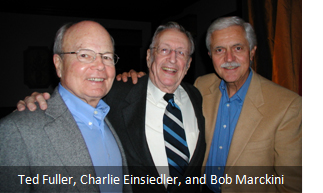 Charlie loved reading our newsletter. He told us he looked forward to each BOB Tales with “great anticipation.” He also loved his conversations with Bob Marckini—they spoke several times over the past 16 years. Bob and his wife, Pauline, also enjoyed many dinners with Charlie and his lovely wife, Betty, along with Charlie’s friend, BOB member Ted Fuller, and his wife, Kris.
Charlie loved reading our newsletter. He told us he looked forward to each BOB Tales with “great anticipation.” He also loved his conversations with Bob Marckini—they spoke several times over the past 16 years. Bob and his wife, Pauline, also enjoyed many dinners with Charlie and his lovely wife, Betty, along with Charlie’s friend, BOB member Ted Fuller, and his wife, Kris.
One of the nicest things you can say about an individual, in our opinion, is that he or she is a good listener. That’s Charlie Einsiedler. He was always filled with energy and enthusiasm. Each time he spoke with Bob, he shared his thoughtful and analytical views on current events as well as the work he was doing to design a more fuel-efficient combustion engine. He told Bob, of his regrets in having to give up golf in his mid 90s “… because I find myself getting tired after playing 18 holes (!)”
Charlie walked a mile or more every day until he passed, and he often spoke fondly of his happy memories of proton treatment at LLUCC.
We will miss our friend.
BOB Member Pens Third Book
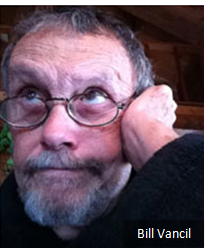 BOB member Bill Vancil once took a job as a one-dollar-an-hour radio announcer, and later went on to become executive vice president, general manager, and part owner of five mid-west radio stations. Bill was later inducted into the Wisconsin Broadcasters Association Hall of Fame. He is also an accomplished graphic designer, painter, and photographer.
BOB member Bill Vancil once took a job as a one-dollar-an-hour radio announcer, and later went on to become executive vice president, general manager, and part owner of five mid-west radio stations. Bill was later inducted into the Wisconsin Broadcasters Association Hall of Fame. He is also an accomplished graphic designer, painter, and photographer.
When diagnosed with aggressive prostate cancer in 2004, Bill did his homework, chose proton therapy, and had a wonderful outcome. He documented his prostate cancer journey by authoring a book, Don’t Fear the Big Dogs. His next writing endeavor was a children’s book, Roy and Kitty, a photographic story of the love affair between two of his best friends, his dog, Roy, and his cat, Kitty.
He’s done it again. Bill just finished his third book—Almost an Addict—about his “unintended dependency on oxycodone” and his “struggle to end it.” You see, Bill also had two liver transplants in 2010. His book details how he left the hospital after three months physically dependent on pain killers. Bill explains how he became dependent and how he eventually accomplished withdrawal. Learn more about Bill’s new book.
Bill has done much to support proton therapy and our organization over the years. He has served on the Proton Advisory Council at LLUCC; he is a volunteer on our proton patient reference list, helping newly diagnosed men learn about proton therapy for prostate cancer; and he has written an account of his journey on our website.
.gif)
We have been producing BOB Tales newsletters monthly for 16 years. During this time there have been important articles that many new members have not seen, and some long-term members may have forgotten. So, we are periodically re-running some articles from past newsletters. This one is from April 2004.
Selling a Used Car and Erectile Dysfunction …?
What could these two topics possibly have in common? Bob Marckini recently sold his daughter’s car to a 70-year-old gentleman from New Bedford, MA. During the negotiations, they somehow got into a conversation about prostate health and prostate cancer (That happens a lot with Bob!). The gentleman told Bob he had surgery for prostate cancer several years ago and one resulting side effect was erectile dysfunction. He had much praise for a non-profit organization called the American Federation for Urologic Disease (AFUD), which he said provided him with considerable help for his problem. It sounded like an interesting lead, so Bob called them and spoke with their Advocacy Director, Anthony Caputi.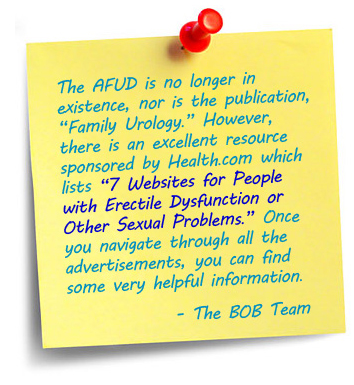
The AFUD organization’s mission is the prevention and cure of urologic disease, through the expansion of patient education, public awareness, research and advocacy. It processes 5,000 phone calls monthly and channels $2.4 million annually to research and public education initiatives. Their publication, Family Urology, has a circulation of over 100,000 subscribers; and they have distributed over 6 million brochures to patients, doctors and others.
Erectile dysfunction is just one of many urological conditions for which AFUD provides support. There is an online brochure, for example, which explains the causes of ED, reviews 8 treatment options and lists several organizations that provide help with ED, impotence, and other sexual function issues. Their website is www.afud.org and their phone number is 410-468-1800. We encourage members who are dealing with ED issues to contact AFUD for information. We reviewed their 90-page Resource Guide for Prostate Cancer, a nice publication except for the fact that they allocated only a half a sentence to proton treatment.

The Beam of Hope: Proton Technology
Every day, researchers are studying new, potential applications for the proton beam. Radiation oncologists are conducting studies to determine new and better ways to use proton therapy to benefit and be available to more patients. Doctors are using proton technology to treat new cancer sites (reducing side effects in the prostate, eyes, head and neck, lung and skull base) and eliminate seizures in children.
Story after story in social media illustrates the struggle to gain access to proton therapy, yet others discuss the undeniable advantages of this precision form of treatment. There are several research programs underway to improve the technology, treat new tumor sites and reduce the cost of proton therapy. But it’s slow-going. Although many of the goals are in sight and the researchers are working hard, adequate funding is still the main roadblock to progress.
How We Help
Every November, Bob Marckini and his wife, Pauline, contribute to LLUCC’s proton research program as a way of saying “thank you” for the gift they have received. They have also placed LLUCC proton research in their estate plan. Deb Hickey also makes a yearly gift to LLUCC’s proton research program and has placed LLUCC in her estate plan. Many of our members have done the same.
Sixteen years ago, Bob was being treated with proton therapy at LLUCC. At the time, LLUCC was celebrating the tenth anniversary of their proton treatment center. He vividly remembers two of the speakers. One was Jennifer Gardner, a 19 year-old woman who had been diagnosed a few years earlier with a brain tumor behind her eye. When surgeons operated on her, they discovered two tumors and told her they were inoperable. She was sure she was going to die. But her life was spared when her parents discovered proton therapy. She is alive and well, and cancer free today.
Another speaker that day was Daniel Alter, a young man who had a tumor wrapped around his brain stem. The doctors told his parents there was nothing they could do. “Just take Daniel home and hug him,” they said. Daniel’s parents didn’t give up. They too, discovered the proton beam. When Daniel was introduced to the audience at the tenth anniversary celebration, he said, not only is he cancer-free; he was back in college, president of his senior class, and getting on with his life. Today Daniel is a practicing Rabbi and is cancer free.
There are countless stories like Jennifer’s and Daniel’s. And there are many more yet to be written. We can help write these stories by supporting proton research. Keep in mind that the technology that benefitted us was a result of research that was funded by others. Part of our mission as a support group is to “Give Something Back.” One of the best ways we can do this is to support proton research at LLUCC—the institution that started it all.
Please consider making a contribution and/or putting LLUCC proton research in your estate plan. There are many ways to do this, and it can be for any amount. This is the perfect time of year to do so.
How to Contribute to Proton Research
Give Now: Visit the LLUH website and donate online. Make sure the “Designation Type” is set to “Proton” and the “Designation” is set to “Robert J. Marckini Chair.
Send a Check: Make your check out to “LLUCC Proton” with “Marckini Chair” in on the memo line and send to:
LLUH, Office of Philanthropy
P.O. Box 2000
Loma Linda, CA 92354.
Make a Call: Contribute by phone. Contact Elvia DeHaro at 909-558-5010

Series: “Make Vegetables Taste Good”
This is the fourth story on a subject that’s’ certainly consistent with our Anticancer series. As we mentioned previously, Deb Hickey set off on a mission to find recipes that make the healthiest vegetables something to look forward to at dinnertime. She learned a lot about specific vegetables and how some fight specific health issues while others interact with each other to become “super” foods that target specific cancers. After much research and experimentation, we are happy to share what we’ve learned.
We will continue to share recipes on how to make vegetables less boring and more appetizing. Remember, these are dishes that Deb and Bob have tried. We have chosen our favorites to share with our readers. Have a vegetable-based recipe that you find irresistible? Send it to us!
Breakfast Smoothie (Makes Kale Taste Like Dessert!)
This is the smoothie recipe that Deb makes for her husband every morning. It has been Mark Hickey’s breakfast for two and a half years. If you recall, Mark’s pancreatic cancer is in remission for over two years. His oncologist recently commented, “I don’t know what you’re doing, but keep doing it.” Maybe it’s the smoothies …
- 1 medium-size banana
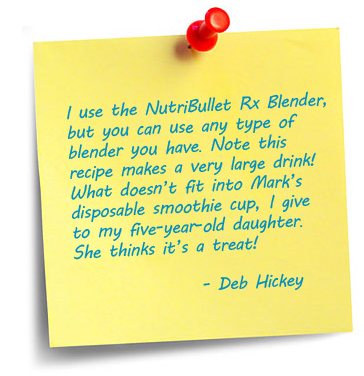 1/2 organic apple
1/2 organic apple- 1-2 large branches of organic kale (about a cup)
- 1 cup of organic broccoli florets
- 5-6 large frozen organic strawberries
- 1/2 cup of frozen organic blueberries
- 1 cup of pomegranate juice
- 1 heaping tablespoon of Pure Synergy
Organic Green Superfood Powder - 1 heaping tablespoon of Linwoods
ground flaxseed, almonds, brazil
nuts, walnuts & co-enzyme Q10 - 1 heaping tablespoon of organic
chia seeds - 1 heaping tablespoon of organic,
dried goji berries - Cup of crushed ice
- 1/2 cup to 1 cup of water
Let us know what you think!
If you try one of our suggested recipes, please let us know what you think.
Have your own recipe for a seriously tasty vegetable dish? Share it with us. If we try it and love it, we’ll post your recipe in an upcoming newsletter, give you full credit, and send you a signed copy of Bob’s book as a “thank you.”
New “Live It” Video: Laughter and Memory
Loma Linda, CA has been designated a “Blue Zone” by National Geographic as one of the five communities in the world with the longest-living inhabitants. Residents of Loma Linda are 10 times more likely to make it to 100. So, perhaps we should pay attention to how they live their lives. Learn how laughter can improve your short-term memory on the following page.
“When we laugh, the stress hormone, cortisol, decreases and thus, our short-term memory will improve,” says Dr. Mark Reeves, surgical oncologist and Live-It video co-host.
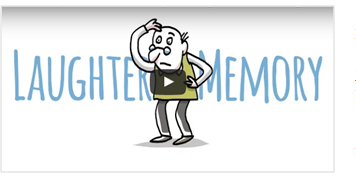 Video: Laughter and Memory
Video: Laughter and Memory
Ever forget where you put your keys? Or maybe that one word is at the tip of your tongue, but you just can’t remember it? Short-term memory loss can be a common occurrence, especially when we’re stressed out. This is no laughing matter … or is it?
Watch the video to learn more.

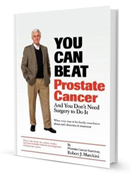
If You Haven't Already ...
Please help keep Bob Marckini’s book on the Amazon “radar screen” by posting a review. The more positive reader reviews the book has, the more likely Amazon’s search engine will “recommend” the book to readers of other prostate cancer-related books.
A new member recently told Bob that his urologist encouraged him to read Dr. Patrick Walsh’s book, Guide to Surviving Prostate Cancer. When he found it on Amazon, there was a message on the page that read, “Customers who bought this book also bought You Can Beat Prostate Cancer by Robert Marckini.” So he bought Bob’s book and read it. This gentleman recently completed his proton treatment at LLUCC and was grateful for the encouragement he received from Amazon to buy Bob’s book. Read his review below.

Thank you, Mr. Marckini, for writing your book and for your honesty about your own journey through prostate cancer. After the shock settles in and you leave the doctor’s office, it’s hard to know where to begin. Your book was an amazing starting point, containing a wealth of information. As we continued through consults, procedures, and multiple tests, the information that we had gleaned from your book was an immense help to us, not only in the questions that we asked, but the decisions that we ultimately made. You gave us hope.
Was Bob’s book helpful to you? If you haven't already, please post a review on Amazon today.
Buy Online, in Bulk or in Spanish
Online: Paperback: $19.00--•--Kindle: $9.99--•--NOOK Book: $9.99--•--Apple iBook: $9.99
In Bulk: Conctact us for a discount price list. Proceeds from book sales support proton therapy research through the Robert J. Marckini Endowed Chair at LLUCC.
In Spanish: Buy the print version or in eBook format.

Medicare Scams: How to Protect Yourself
It’s that time of year again—Medicare Open Enrollment. In addition to the challenge of sifting through the myriad plan options, some say Medicare open enrollment is also prime time for Medicare scams. So, what can you do?
The most obvious answer, perhaps, is to guard your Medicare number, which in most cases, is your Social Security number. Don’t give it to anyone unless you are certain they are part of your health care team. Second, note that Medicare will never call or email you with product offers.
Five Common Medicare Open Enrollment Scams:
1. Switching plans is a must: Some insurance agents tell their clients they must change their Medicare Advantage and Part D prescription drug plans and failing to do so could cause loss of coverage. This is not true. Although experts say shopping your options each year is the best way to ensure you’re still covered by the best plan for you, you’re not required to do so.
2. Medicare is changing cards: Be on the lookout for anyone who tells you Medicare cards are changing and that to get your new card you just need to update your information. Again, Medicare will never call you, show up at your door, or ask you for personal information via email.
3. For you, a special price: High-pressure pitches for Medicare insurance policies that come with especially low costs are common during open enrollment. If an agent tells you that for a limited time you can sign up for an “early bird discount,” it’s probably a scam.
4. Health fair scams: Be careful at health fairs or other events during the open enrollment period. Scammers may advertise a free gift, asking you to submit your Medicare number for a prize.
5. Phony organizations: Be on the alert for calls from people saying they’re from your doctor’s office or state or local health agencies. Sometimes crooks get illegal access to your personal information and use it to lure you into sharing more details. Do not give them your Medicare number.
Surprising Causes of Back Pain
 Most people think their back pain is caused by an injury or genetics. But, according to Dodd Sinett, DC, Midtown Integrative Health & Wellness, in many cases back pain can be caused by things you would never expect, such as:
Most people think their back pain is caused by an injury or genetics. But, according to Dodd Sinett, DC, Midtown Integrative Health & Wellness, in many cases back pain can be caused by things you would never expect, such as:
A Big Wallet: Especially if kept in your back pocket. When you sit on your wallet, one buttock is higher than the other and this can cause pelvic misalignment and spinal twisting over time, leading to chronic back pain.
Oversized Bags: When you carry a heavy, oversized bag, the working shoulder elevates and puts the spine out of alignment. Also, “bag jerk” can occur when a heavy bag slips off the shoulder causing a jerk to the body which can result in shoulder and back sprain, similar to a sports injury.
Flip Flops: These casual shoes provide no support and their thin soles are often a cause of heel and arch problems. Knee, hip, and lower back pain can be caused by wearing flip flops. Some say that wearing flip flops is worse than walking barefoot.
Too Much Sitting: Sitting is sometimes called the “new smoking” because it has been linked to type-2 diabetes, cancer, and heart disease, not to mention back problems from prolonged sitting and slouching.
Constipation: A lack of regular bowel movements can cause buildups of inflammatory wastes that irritate the large intestine, which can irritate muscles in the back.
Chewing Gum: Back muscles can be strained by stresses on the poromandibular joint caused by too much jaw action.
Estate Planning Hints
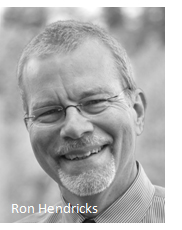 BOB member Ron Hendricks is Director of Gift Planning for Trinity Western University. He regularly copies us on his “News from Ron” mailings, which are helpful hints on estate planning to the readers of his newsletters. We have found Ron’s suggestions to be timely and beneficial. With his permission we periodically share some of his wisdom with our membership.
BOB member Ron Hendricks is Director of Gift Planning for Trinity Western University. He regularly copies us on his “News from Ron” mailings, which are helpful hints on estate planning to the readers of his newsletters. We have found Ron’s suggestions to be timely and beneficial. With his permission we periodically share some of his wisdom with our membership.
Successful Children and How You Can Help
A primary goal as a parent is to help each child be a successful person—not just financially, but also in his or her career, family life, and their walk with God. Proverbs 22:6 says, “Train up a child in the way he should go; even when he is old he will not depart from it.”
While attorneys and CPAs are trained to help you transfer property to children, a good inheritance plan is much more than just transferring property. There are many plans that are successful in transferring property but lead to a very bad result. Yes, a successful plan transfers property. But good planning transfers at the right time, the right way, and in the right amount so that it achieves a good result. While a good result cannot be guaranteed,
a plan with integrity and initiative will increase the probability of that favorable result.
One principle to follow is to spread the resources out over time. This gives children time to learn. Parents have usually acquired an estate over 30 or 40 years. If you ask a person of retirement age to recall their early years, they will frequently share stories of the financial “bumps in the road” that were very educational. Without that education, they would not have been as successful in life or in their finances. You do not want to deny
your children this valuable education.
A good plan could transfer property in four ways:
- Gifts during life—property or stocks is better than cash
- Principle after the parents pass away—bequest from estate
- Income for a period of years—a charitable remainder unitrust
- Delayed principle—an annuity lead trust

Last Month’s Brain Teaser
We said it was one of the toughest we’ve ever presented:
Is it possible for an object to be at one point on this earth on two different days, in two different months, in two different seasons, on two different years and in two different centuries … all at the same time?
If your answer is “Yes,” please explain how this can happen.
Answer: Yes, this is possible. And here is the explanation …
True Story
The passenger steamer SS Warrimoo was quietly knifing its way through the waters of the mid-Pacific on its way from Vancouver to Australia. The navigator had just finished working out a star fix and brought the master, Captain John Phillips, the result. The Warrimoo’s position was latitude 0 degrees x 31 minutes north and longitude 179 degrees x 30 minutes west.
The date was 30 December 1899. Know what this means? First Mate Payton broke in, we’re only a few miles from the intersection of the Equator and the International Date Line.
Captain Phillips was prankish enough to take full advantage of the opportunity for achieving the navigational freak of a lifetime. He called his navigators to the bridge to check and double check the ships position. He changed course slightly so as to bear directly on his mark. Then he adjusted the engine speed. The calm weather and clear night worked in his favor. At midnight the Warrimoo lay on the Equator at exactly the point where it crossed the International Date Line.
The consequences of this bizarre position were many. The forward part of the ship was in the Southern Hemisphere and the middle of summer. The stern was in the Northern Hemisphere and in the middle of winter. The date in the aft part of the ship was 31 December 1899. Forward it was 1 January 1900.
This ship was therefore not only in two different days, two different months, two different seasons and two different years but in two different centuries—all at the same time!
Winner: We received just four correct answers last month! Bill Forbes of Naples, FL was the first. Incidentally, we wrote a featured member story on Bill back in 2008 and his response prompted us to dig it out. Here’s an excerpt:
World Traveler, Author, and Broadcast Journalist (He’s interviewed 4 U.S. Presidents!)
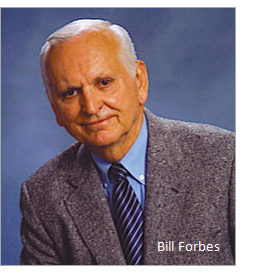 Bill Forbes joined the U.S. Navy in 1957. He served as a Radarman on board a Navy Destroyer and a Troop Transport in the Pacific Fleet. After retiring from the Navy, Bill attended a course at Brown Institute of Broadcasting in Minneapolis, MN. He then began a 20-year broadcast journalism career. He worked at radio stations in Astoria, OR, Minot, ND, and Canton, OH, before retiring in 1973. Bill then began his career as a civil servant in Washington, D.C. In 2004, he wrote an autobiography called, An Anchor in the Prairie.
Bill Forbes joined the U.S. Navy in 1957. He served as a Radarman on board a Navy Destroyer and a Troop Transport in the Pacific Fleet. After retiring from the Navy, Bill attended a course at Brown Institute of Broadcasting in Minneapolis, MN. He then began a 20-year broadcast journalism career. He worked at radio stations in Astoria, OR, Minot, ND, and Canton, OH, before retiring in 1973. Bill then began his career as a civil servant in Washington, D.C. In 2004, he wrote an autobiography called, An Anchor in the Prairie.
In 2010, Bill visited his family doctor for a routine check-up. He discovered that he had prostate cancer and immediately began researching the Internet for treatment options. Bill initially thought: If I have prostate cancer, I want it removed as soon as possible. But after speaking with a former surgery patient, he changed his mind. He then discovered proton therapy and Bob Marckini’s book, You Can Beat Prostate Cancer: And You Don’t Need Surgery to Do It. Bill said, “The title cannot help but get the attention of a man who has prostate cancer.” Bill also communicated with BOB members before making his treatment decision.
Bill was treated at LLUCC in 2011. He said, “During my treatment, the only discomfort I felt was from the embarrassment I had walking down the hall in that fashionable garment—you know the one ...”
Bill is now retired and lives in Naples, FL. He recently took a tour through Portugal, Morocco, and Spain. “Life is good,” he told us. Bill has had no side effects from proton treatment; his PSA remains low; and he’s feeling “terrific.”
Congratulations, Bill! Your signed copy of Bob Marckini’s book is on the way!
New Brain Teaser
This one’s for the mathematicians in our group. We apologize in advance—it’s a tough one.
A high school math teacher told the class that mathematics is not an exact science and used a set of equations to illustrate his point. The result was that 1 = 2, which can’t be … or can it? Here is the explanation he used.
Let’s say A = 1 and B = 1. The A = B correct? If A = B and you multiply each side of the equation by A, you get A2 = AB. If you then subtract B2 from both sides, you get A2 – B2 = AB – B2. Factoring both sides makes the equation (A + B)(A – B) = B(A - B). Then dividing both sides by (A – B) leaves A + B = B. And knowing that A = B, this means that B + B = B, or 2B = B, or 2 = 1.
Crazy, right? But there is an explanation. The first with the correct answer is the winner and will receive a signed copy of Bob’s book. If you think this math is faulty, ask your high school aged child or grandchild and they will confirm the math is correct.
Send your brain teaser answers to [email protected] for a chance to win a signed copy of Bob’s book.
And Then the Fight Started …
My wife was hinting about what she wanted for our upcoming anniversary. She said, “I want something shiny that goes from 0 to 150 in about 3 seconds.”
I bought her a bathroom scale. And then the fight started …
Answering Machine Message
“I am not available right now, but thank you for caring enough to call. I am making some changes in my life. Please leave a message after the beep. If I do not return your call, you are one of the changes.”
From The Mouths of Babes
On my way home one day, I stopped to watch a Little League baseball game that was being played in a park near my home. As I sat down behind the bench on the first-base line, I asked one of the boys what the score was. “We’re behind 14 to nothing,” he answered with a smile. “Really,” I said. “I have to say you don’t look very discouraged.” “Discouraged?” the boy asked with a puzzled look on his face. “Why should we be discouraged? We haven’t been up to bat yet.”

Quote of the Month:
“What if you woke up today with only the things you thanked God for yesterday?” —Unknown


Giving Thanks
Written by Deb Hickey
When my dad was diagnosed with prostate cancer in 2000, our family thought our world was ending. Never did we suspect at the time that his diagnosis would lead to the miracle that we live today: My father in perfect health and the two of us spending time together helping people with prostate cancer.
Every day, and especially at this time of year, we are thankful to God for all He has given us, and also the people and organizations that help us with our mission. Without you, this “ministry” would not exist.
The list is long, and we always run the risk of leaving someone out, and for that we apologize.
Thank you, our members, for your devotion to “the cause,” for sharing with others your knowledge and passion for proton therapy, for the constant feedback and messages of gratitude, for those who have volunteered to help others who haven’t yet found their way, and for your ongoing generosity through gifts for proton research, Vision 2020 and the Robert J. Marckini endowed chair.
Thank you, Dr. James M. Slater, Dr. Jerry Slater and Loma Linda University Cancer Center, for pioneering proton therapy for prostate cancer and other diseases 26 years ago so that tens of thousands could have their cancers cured and the quality of their lives preserved. Thank you also for your support of the Brotherhood of the Balloon, your encouragement, and your unwavering faith in our mission.
Thank you, LLUCC senior management for your support of our efforts in so many ways.
Thank you, all the proton centers, for acknowledging the significant benefits of proton therapy, for making the capital investment to build 26 proton centers in the US and for enabling thousands more patients to benefit from this technology.
Thank you, Todd Ketch and the National Association for Proton Therapy, for building awareness and educating others about proton therapy, for your support of our organization, and for being a valuable resource. Thank you also for recognizing my father’s contributions through his “pioneering and voluntary leadership to improve the lives of thousands of prostate cancer patients” and awarding him the NAPT Lifetime Achievement Award at the 2016 NPC conference in New Orleans.
Thank you, all the physicians and administrative people connected with proton therapy who routinely make themselves available to us when we are in need of answers to technical questions, information for our newsletters, or support for patients in need .
Thank you, Pat Greany, for contributing to our newsletter and especially for your most recent efforts to introduce our readers to the life-changing book, Anticancer. You go above-and-beyond in your research; your analysis is compelling; and your articles are exceptional.
Thank you, Bob Hawley, for your timely, careful, and professional reviews of our monthly newsletter.
Thank you, Ron Hendricks, for allowing us to reprint your helpful hints on estate planning.
Thank you, Larry Becker and team, for the thorough and timely editorial reviews of our monthly newsletter.
Thank you, Janya Mekelburg, for supporting our daily activities in so many ways and for your responsiveness when obstacles surface.
Thank you, our members and friends who have contributed to the Robert J. Marckini Endowed Chair at Loma Linda University Cancer Center. Thank you for helping to advance proton therapy and make a difference in people’s lives for years to come.
And a very special thank you, to Dr. Lynn Martell, for your friendship and support over the last 16 years, for recognizing our potential at the very beginning, and for fostering our growth in so many ways.
With the help of these people, we are making a difference: Our members are well informed ambassadors for proton therapy; our group is responsible for introducing hundreds of men each year to proton therapy; and we have responded to assaults and misinformation on proton therapy as well as attempts to stop reimbursing for proton treatment. Through our members, we have raised almost $12 million, most of which was directed to proton therapy research. We are proud of our group and thankful for our members and all who support our efforts.
We would like to wish you all a very special Thanksgiving.
Low PSAs to all!
Bob Marckini and Deb Hickey
To print the BOB Tales newsletter or view the newsletter with a larger font size, click here for the PDF file.
NO MEDICAL ADVICE: Material appearing here represents opinions offered by non-medically-trained laypersons. Comments shown here should NEVER be interpreted as specific medical advice and must be used only as background information when consulting with a qualified medical professional.
